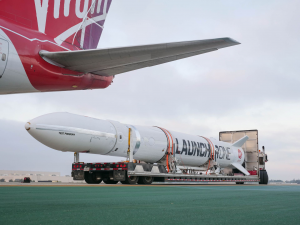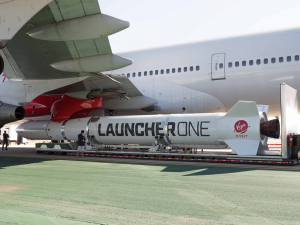
Virgin Orbit moves closer to launching a rocket to space
Virgin Orbit attached its prototype rocket, LauncherOne, to a modified 747 for the first time at an airport in Long Beach, California. The company hopes to send the rocket into orbit early next year. LauncherOne is 70 feet long and weighs 57,000 pounds. It’s designed to carry small satellites into orbit around Earth. But instead of blasting off directly from the ground like a typical rocket, LauncherOne will start its journey on a runway.
The rocket was attached to Cosmic Girl, a 747 that used to carry passengers as part of the Virgin Atlantic fleet “The team were carrying out the integration check of the rocket with Cosmic Girl to verify mechanical, electrical, software, and dynamics all work together for the first time,” Virgin Orbit owner Richard Branson wrote in a blog post. “It’s an incredibly exciting moment for us, as Virgin Orbit’s first test flights move ever closer.”
To prepare for the eventual test flights, engineers altered the plane, stripping out seats and bulkheads from its interior to cut down on weight. Cosmic Girl is now designed to take off carrying LauncherOne under one of its wings.
The plane will fly LauncherOne to an altitude of about 30,000 feet. At that point, the rocket will release from the plane and engage its thrusters to travel into orbit at speeds of up to 17,500 miles per hour, which is 20 times the speed of sound.


Using a plane to assist with the rocket launch, Virgin Orbit hopes to offer satellite launches on shorter timelines and at lower prices than competitors, many of which rely on expensive ground-based infrastructure. The company eventually hopes to launch from multiple locations around the world, including the United Kingdom.
Virgin Orbit is a spinoff of Virgin Galactic, the space tourism company also owned by Branson. While Virgin Galactic is focused on bringing people to space, Virgin Orbit’s goal is to launch small satellites into space. Since its founding last year, the company has already signed on several customers for future satellite launches, including the Department of Defense and the European Space Agency.




